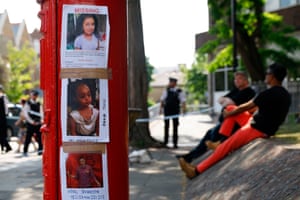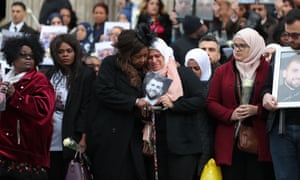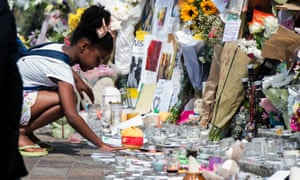There was an Afghan army officer, a Sudanese dressmaker, a British artist and an Italian architect. There was an Egyptian hairdresser, an Eritrean waitress and a Lebanese soldier.
There were taxi drivers and teachers, football fans and churchgoers, devout Muslims, big families and working singletons. People whose lives were complicated by health issues or love or both. Neighbours on nodding terms, and friends for life from the flat next door.
Ever since the deadliest fire in Britain for a century gutted Grenfell Tower last June, much has been made of the catastrophe, from the cladding and the council to the structure and the stairwells.
But who were the victims? In the weeks after 14 June, most became known only two-dimensionally – a few facts from a police statement or inquest, a brief, tearful family tribute, a picture posted during the desperate search that ensued on that blistering June week.
The Guardian has spent the subsequent months trying to fill in the blanks, finding out about the lives of these Londoners. We have talked to as many families as were willing to speak, and asked friends and colleagues for anecdotes and their favourite memories.

With parliament poised to debate the tragedy, and with the public inquiry due to start next week with individual tributes to all 71 victims, we are publishing our own portraits of the deceased.
Not all families wanted to contribute: their grief is still too raw. But the majority did, and the details about individuals – and about the group as a whole – say a lot about 21st-century Britain.
The makeup of the 71 people who died shows how diverse, open and tolerant Britain has become in the past 30 years (more than half the adult victims had arrived in the country since 1990).
The Grenfell lives closely mirror the complexities of modern Britain: young families scrambling for childcare cover and extra jobs to help pay the bills; people still living with parents well into their 20s and 30s; refugees who abandoned careers and status in perilous homelands for safe anonymity half a world away; the very elderly – there were seven victims aged over 70 – grappling with disability in a crowded health system.

But Grenfell was not a microcosm of Britain or London. There were few white-collar workers among the victims and only seven white Britons , indicative of how the disaster disproportionately affected minority ethnic communities.
There were children – 18 of them, including one who died before he had even been born. There were 18 different nationalities. The median age was similar to the national median of 40. The oldest victim was 84, the youngest after the unborn child was six months. There were 28 women and 25 men.
A 72nd individual died in hospital in January, from complications sustained after the fire. She has not yet been counted in the official death toll, but has been named as Maria De Pilar, known as Pily, who was rescued from the 19th floor on the night of the fire.
Four victims did not live in Grenfell Tower. Of those who did, many loved it despite the shortcomings that had been pointed out repeatedly.
“He was so proud of that flat,” said Karim Mussilhy of his uncle , Hesham Rahman, originally from Egypt, who lived on the 23rd floor. “I remember when he first got it – all the furniture he bought, and how much effort he put into decorating.”
For Sakineh Afrasiabi, an Iranian victim, the only thing her 18th-floor flat needed after she moved in was a pair of binoculars. “She used to say: ‘It’s as if I’m on a plane, I can see the whole of London from up here,’” said her daughter, Nazanin Aklani.
The first-generation immigrants fall into two groups. There were those who came to Britain while young, to seek their fortune. Some of these, such as Ligaya Moore from the Philippines or Marjorie Vital from Dominica came long ago; others such as the Italian sweethearts Marco Gottardi and Gloria Trevisan arrived more recently.
“They were two people who had the great strength to start a professional path abroad all by themselves,” said Gianni Gottardi, Marco’s father.
The second group chose Britain out of necessity, when lives in their homeland became unliveable. They went through the tortuous rite of passage of the refugee: uprooted, bereft, in limbo and then finally able to start a new life, albeit with none of the professional status or social standing of the lives they left behind.

There was Mohamed Neda, an Afghan army officer turned London minicab driver; Fathia Alsanousi, a Sudanese teacher who worked in a British packaging factory; Ali Yawar Jafari, an Afghan jeweller who found work in a west London shop; Mohamednur “Mo” Tuccu, an Eritrean university student who ended up as a security guard.
The biggest national group other than Britons were Moroccans. Remarkably, most of the six deceased Moroccans, and their five British-Moroccan offspring, had some connection with the port town Larache.
The Grenfell victims were also a versatile group professionally: a chambermaid, a waiter, a painter-decorator, a retailer, at least two taxi drivers, two nursery workers and a scrap metal dealer were all among their number.
Many gestures have been made to ensure that their memory lasts: University College Hospital dedicated a memorial bench to Abdulaziz El Wahabi, who worked as a porter; Chelsea football fans honoured Denis Murphy with a 56th-minute ovation at Stamford Bridge days before his funeral; a character in an upcoming Philip Pullman book is to be named after the teenager Nur Huda El Wahabi; Gottardi and Trevisan are commemorated by the Grenfellove Marco and Gloria foundation.
Our digital memorial is dedicated to them and the rest of the victims.